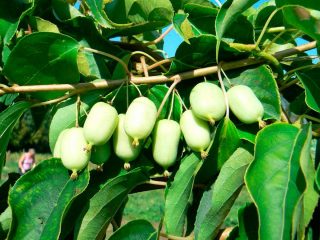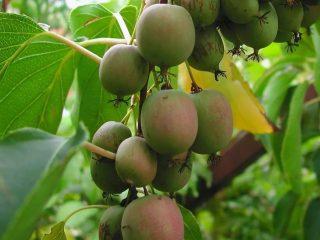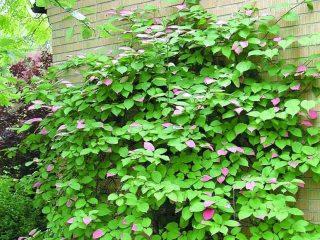Content
Actinidia has taken root in the Urals for a long time. For successful cultivation, it is important to choose varieties with high winter hardiness and relatively short ripening periods. An overview of popular varieties and instructions for growing them can be found in this article.
The best varieties of actinidia for the Urals
When choosing varieties for the Urals, attention is paid to actinidia with high winter hardiness. The minimum value should be -30 degrees. In addition, it is important to take into account the timing of fruit ripening and their taste. The most popular varieties that meet these criteria are described below.
Gourmand
Lakomka is a variety for the Urals that produces a harvest only at the end of August. At the same time, the vine grows slowly, and the shoots are quite thin. However, the leaves are large; veins are noticeable on the surface, standing out with their relief. The flowers grow solitary and are similar in shape and color to lilies of the valley. The frost resistance indicator is very high - actinidia can withstand up to -40 degrees.
Produces fairly large fruits of a rich dark green color. The average weight is 5 g.The taste is balanced, with pronounced sweetness and delicate sourness. The pulp is juicy, not very aromatic, but you can notice a slight hint of pineapple.

The yield of the Lakomka variety reaches 6-7 kg
Actinidia hybrid
The hybrid variety (Actinidia arguta x Actinidia purpurea) is a hybrid with high winter hardiness. The fruits take a long time to ripen, reaching full ripeness only at the beginning of September. At the same time, the vine itself grows quickly - adult representatives reach a length of 7 m or more. The shoots curl well, have no thorns, and are colored green.
The leaf blades are bare, soft, green in color. The flowers are single type, pure white, and give off a pleasant scent when the buds open. The actinidia hybrid for the Urals is distinguished by early fruiting - from the age of three. At the same time, many other representatives bear fruit only from 5-7 years. The berries are large, greenish and red in color. The taste is sweet, without noticeable sourness. The aroma of fruits and sweets is noticeable.
But there is also a drawback associated with low immunity. Foliage and berries can suffer from fungal infections. Phyllostictosis is especially common, when the plates become covered with round-shaped spots with pronounced boundaries.

Actinidia hybrid forms large fruits weighing up to 10 g
Doctor Szymanowski
A variety of Polish origin, Dr. Shimanovsky, produces shoots 2 m long. Frost resistance is very high - up to -40 degrees, which allows it to be grown even in the Urals. The color of the shoots is brown, glossy. The leaves are bright green, spots are pinkish, snow-white. By autumn they turn yellow and acquire purple and scarlet shades.
Flowering of this variety of actinidia, suitable for the Urals, begins at 5-7 years.The inflorescences are small in size, white in color, and appear within three weeks. The fruits ripen for quite a long time - up to 4.5 months, which is not always suitable for the conditions of the Urals. The fruits are small, only 2 cm long, 3 cm in weight. The color is typical, light green, the flesh is juicy, sweet and sour.

The color of the foliage of the Doctor Szymanowski variety is brighter, the more sun there is
Queen of the Garden
Garden queen is a Russian variety of actinidia suitable for cultivation in the Urals. A dessert variety with juicy berries with a refreshing sweet and sour taste. They give a pleasant aroma reminiscent of apples. According to tasting characteristics, the taste rating is very high - 4.8 points.
The plant is winter-hardy, can withstand down to -35 degrees, so this actinidia can be cultivated in the Urals and neighboring regions. The foliage is shiny, lime color. The fruits are larger than some other varieties, weighing up to 4.5 g, length 3.5 cm. The color is greenish-gray with a reddish tint.

The length of the shoots reaches 9 m
Waffle
Waffle (Actinidia kolomikta Vafel’naya) is another actinidia variety for the Urals, bred in Russia. Its winter hardiness is not as high as, for example, that of the Queen of the Garden, but it is also sufficient. Liana can withstand frosts down to -30 degrees. In addition, the plant has good immunity. The berries are very large, weighing up to 8 g and often exceeding this value.
The fruits of this variety of actinidia for the Urals have the shape of an ellipse, and the base is flat, as if cut off. The color is greenish, with a brown tint, the surface is matte. The taste is good - 4.7 points according to the tasting assessment. A slight sourness and banana aroma are noticeable. Actinidia shoots for the Urals reach a length of 7-8 m, a thickness of up to 4 cm, and with age - up to 10 cm.The color is green, the flowers are single, the petals are white.

The yield of Actinidia Waffle for the Urals reaches 8 kg per vine
Folk
The actinidia variety for the Urals Narodnaya belongs to the medium category (in terms of ripening). The liana does not grow so quickly, but it produces fairly large fruits weighing up to 4.5 g, having an oval shape. The shoots are curly in shape, brown in color, and have a smooth surface. The foliage is bright green, fades a little in the sun and turns yellow. The reverse side is light green, whitish.
The edges of the actinidia leaf blade for the Urals have characteristic small teeth. The plant's immunity is good, but it may suffer from pests. Therefore, preventive examinations and treatments are required in spring and summer.

Actinidia Narodnaya for the Urals produces quite tasty sweet and sour fruits
Hope
Another well-known actinidia variety for the Urals is Nadezhda. This is a variety of Belarusian selection. It produces 4-5 kg per vine and has good immunity. But drought resistance is low, so you need to water well, especially in the heat.
The first berries appear in the fifth year of life. They are small in size, weighing on average 3 g. The leaves of actinidia for the Urals of this variety are wedge-shaped, with sharply pointed tips. A characteristic advantage is that even after full ripening the fruits do not fall off. Their color is light green, with longitudinal stripes. The pulp is quite juicy, moderately sweet, and the sourness is practically not felt.

The assessment of the taste qualities of the fruits of this variety for the Urals is 4.5 points
Planting actinidia in the Urals
Planting of actinidia is planned only in the spring, if we are talking about the Urals. This could be the second half of May or even the first ten days of June. The place should be well-lit, with slightly acidic or neutral soil. It is better to choose hills, lowlands should be avoided.
The landing process looks like this:
- They determine the location and dig up the soil.
- Install a trellis (vertical support).
- Mark a hole 50-60 cm deep and wide.
- The actinidia seedling is carefully handled.
- Cover with fertile soil, leaving the root collar on the surface.
- Water with settled water.
Actinidia care in the Urals
Despite its exoticism, actinidia is unpretentious. But when growing in the Urals, it is worth considering that some varieties are not resistant to drought, so the vine requires regular watering, especially in the first years after planting.
Trimming
To get a beautiful liana, it is important to carry out timely pruning of actinidia. You shouldn't do it in the spring; it's better to do it in the fall. In the first year it is not carried out, but in the second season all shoots are cut off, leaving 3-4 of the strongest. Then they are pinched annually and the upper buds are removed. In the 3-4th year, shoots from which they plan to get a harvest are cut off - shortened by half. Moreover, they should alternate in vertical and horizontal arrangement, as shown in the diagram.

Scheme for pruning actinidia when growing in the Urals
Watering and fertilizing
The plant is moisture-loving, which is especially important to keep in mind when growing in the Urals, where droughts often occur. Therefore, it is necessary to water every 10 days, i.e. about three times a month. But if it is too hot outside, and the surface layer of soil has clearly begun to dry out, water is given every week - 4 times a month. It should be settled, not cold.Young plants are given 2-3 buckets of water, adults – 5-7.
To get a good harvest, you need to regularly apply fertilizer. After the snow melts, give urea or ammonium nitrate. When buds appear, feed with complex fertilizer. The same composition for actinidia in the Urals is applied every 3-4 weeks until the beginning of August.
Preparing for winter
When growing in the Urals, it is advisable to cover even frost-resistant varieties for the winter. At the end of October, the tree trunk circle is cleared of debris and a high layer of mulch (up to 25 cm) is laid. The shoots are removed from the vertical support and sprinkled with dry leaves, straw, and covered with spruce branches.
Diseases and pests
Some varieties of actinidia, when grown in the Urals, may suffer from various infections, for example:
- phyllosticosis;
- ramulariasis.
If spots are found on the leaves, they are torn off and burned, then treated with an insecticide. These can be different drugs - “Maxim”, “Fufanon”, “Tattu”.
Among pests, the most dangerous are different types of aphids. For destruction, insecticides are used, for example, “Colorado”, “Inta-Vir”, “Karate”, “Decis” and others.
Harvest and storage
Fruiting of actinidia in the Urals begins 3-5, and sometimes 6-7 years after planting. In most cases, the berries ripen from late August to late September. As a rule, the period is extended to 1.5 months. The harvest is harvested when the fruits begin to turn red. If necessary, you can pick them a little unripe and let them sit in the refrigerator for several days.

The harvest is usually harvested at the end of August
Fresh fruits are stored in a dark, cool room, and it is desirable that the temperature be within 10-12 degrees. The period is several weeks.If you need to increase it, it is better to dry or wilt the berries. You can make jam and other preparations.
Conclusion
Actinidia in the Urals can be grown according to general rules, but taking into account the need for regular watering and shelter for the winter. If you plan to use the vine for decorative purposes, care is simplified. If you want to get a good harvest, you need to regularly provide water and fertilizing.
Reviews about growing actinidia in the Urals








